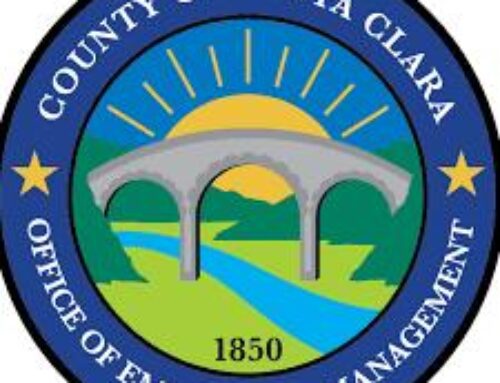Environmental report says impacts can be mitigated
Published in the July 18 – 31, 2018 issue of Morgan Hill Life
By Marty Cheek

Photo by Marty Cheek * More than 300 members of the public heard both sides of the issue surrounding the building of an Islamic worship center in San Martin.
About 100 South Valley Islamic Community families now worshiping in a small San Martin “barn mosque” that once sheltered sheep hope to one day build a new mosque and community building on a 16-acre parcel of land the group purchased in 2006.
To a standing-room-only crowd, the Santa Clara County Planning Commission heard comments from more than 60 people supporting or opposing the SVIC’s Cordoba Center project based on a county draft environmental impact report released May 30. The meeting held July 12 at the Morgan Hill Community Center was occasionally contentious with booing of speakers and with supporters holding overhead signs favoring the project.
Some speakers told the commissioners they feared the Cordoba Center would increase traffic and impact nearby neighbors because of its noise and lighting. Water issues served as major theme of opposition with many speakers expressing concerns of possible flooding of surrounding land and the danger that contamination from the site’s cemetery would pollute the ground water and nearby Llagas Creek.
“Every senior in San Martin can verify a half century of flooding,” Connie Ludewig told the commissioners. “We’ve been victims of flooding from the site that flows all through west San Martin. We’ve endured perchlorate and ongoing nearly annual raw sewage flooding. We have only one source of water — our wells.”

Photo by Marty Cheek * President of South Valley Islamic Community Karen Musa, at right, and Amina Khemici, in orange, celebrate the end of Ramadan June 15.
Ludewig’s home is located on California Avenue just south of the site located at 14065 Monterey Road.
Sacramento-based company Ascent Environmental, Inc., prepared the report and the 60-day public review period ends July 30. Among its findings, the report states noise and lighting at the Cordoba Center would not impact the surrounding neighborhood, which is sparsely populated. No outdoor amplification is proposed in the plans. Outdoor lighting would be in the parking lot area and it would be low-impact and pointed downward.
Traffic safety was a concern brought up in the report because the entrance to the site would be along Monterey Road immediately after a sharp curve around a hill. The report suggested that an acceleration lane be built to allow vehicles exiting the center to safely merge on to the four-lane rural road. No left turns would be allowed.
Contamination of San Martin’s ground water by the proposed cemetery was not likely, the report stated. The cemetery would be located in the western portion of the site many feet above the required distance from the aquifer. Llagas Creek is protected by a large bedrock hill separating the natural waterway from the center, the report said. The project site is not located in a FEMA flood zone.

Photo by Marty Cheek
A man prays at the end of Ramadan at the Morgan Hill Community Center.
Another concern brought up by opponents is the project’s scale is too big for San Martin. The report stated that there are large commercial and industrial structures, such as wineries and warehouses that exceed 50,000 square feet in size. The Cordoba Center’s two-story mosque is planned for 9,000 square feet and the two-story community center building is planned for 14,500 square feet, making up about four percent of building footprint on the parcel. The architecture would be designed in a California Mission style in conformance with the San Martin Integrated Design Plan. Construction would be on a field south of the hill. The hill, dotted with oak trees, would be kept natural. Maximum attendance at religious and cultural events is anticipated to be 300, although special events could include as many as 500 attendees.
To provide privacy and reduce noise, the project’s landscaping would include a fruit orchard and a line of hundreds of native trees bordering Monterey Road.
One reason the SVIC wants to build the Cordoba Center is to provide a legacy for the South Valley community and to uphold the right to freedom of faith, said Hamdy Abbass, a Gilroy resident and businessman who serves on the board of trustees.
“It is important for freedom of religion for everybody,” he said. “In order for them to practice, they have to worship, right? If anybody is Catholic or another Christian faith or Buddhist, they need a place to practice.”
The name “Cordoba” was chosen for a city in Spain where religious tolerance thrived during the Middle Ages and Christians and Jews lived with Muslim in an enlightened scholarly community, Abbass said.
“For 900 years, Cordoba was the best time as far as religion is concerned,” he said. “We picked up that same name because we want to work hand in hand with the other faiths around us and we can have a good community with members from all faiths.”
The SVIC hopes that with the final approval of the EIR, the county will move forward to provide a permit to start construction. The project will go through several more public hearings as well as a study by the county’s Planning Commission before county supervisors vote on the project, possibly in December.
In 2012, permits for the project were unanimously approved by the Planning Commission and the Board of Supervisors. Shortly afterward, opponents sued the county because of concerns on the project’s impact on the environment. In 2013, the SVIC relinquished the entitlements to avoid a long series of court battles. In 2014, they applied again and paid “hundreds of thousands” of dollars to prepare an EIR report, said Karen Musa, president of the SVIC board.
“Is it really fair that somebody buys something for a lot of money and can’t use it, within reason, for what they want?” she said. “I can understand if you want to build something really ridiculous on that land that would impact everybody. But the county is saying, and the county said before, it won’t impact. We did the EIR, and it proves we will not impact the environment.”
If built, the Cordoba Center would welcome all people, she said. The site would be open for weddings, religious celebrations and cultural events.
Friday prayers would bring about 150 people to the site, Musa said. About 300 people would gather at the site on special occasions such as the Eid al-Fitr religious holiday that marks the end of Ramadan, the Islamic holy month of fasting.
“We want the convenience to pray in our own community,” Musa said. “That’s all we want … to pray in the community where we live, like everyone else.”






